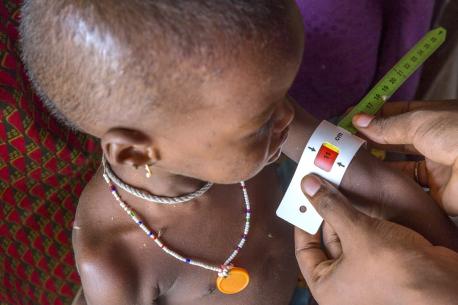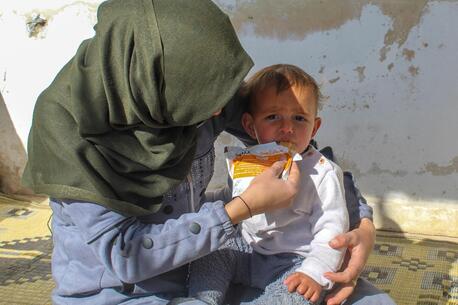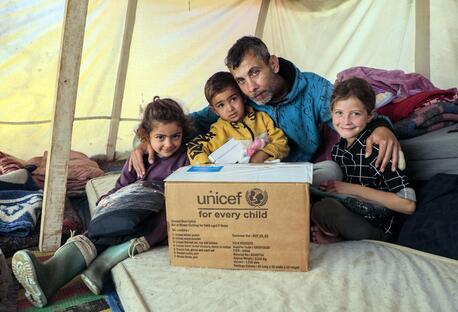
Famine Threatens 2.5 Million Children in Africa and the Middle East
Time is running out for the world to save children from deadly hunger caused by brutal war, violence, displacement and climate change.
Time is running out for millions of children, unless the world acts now.
Famine and lack of a reliable food supply are threatening the lives of approximately 80 million people — more than half of them children — in South Sudan, Somalia, Nigeria and Yemen, and in nine additional countries across Africa and the Middle East. The numbers of children under threat are enormous.
More than 2.5 million face imminent risk of death from severe acute malnutrition. Approximately 4 million children and adolescents may not be able to go to school. Almost 17 million people — including many children — will need lifesaving vaccines, medicine and healthcare.
Six years ago, at least 100,000 children died from famine because the world didn’t act soon enough. Now, it's 2017, and famine is looming again. We cannot let history repeat itself.
Caused by war, intractable violence, displacement, climate change and drought, this man-made crisis menaces the following countries:
- Lake Chad Basin: Cameroon, Chad, Niger and Nigeria
- Eastern Africa: Democratic Republic of the Congo, Ethiopia, Kenya, Somalia, South Sudan, Sudan and Uganda
- Middle East/Northern Africa: Djibouti and Yemen
As UNICEF Executive Director Anthony Lake explains: "We can still save many lives. The severe malnutrition and looming famine are largely man-made. Our common humanity demands faster action. We must not repeat the tragedy of the 2011 famine in the Horn of Africa.”
Once again, brutal war is the primary culprit.
Nigeria, Somalia, South Sudan and Yemen lie at the heart of this spreading hunger. Once again, brutal war is the primary culprit.
Kibrom Tesfaselassie, a UNICEF Nutrition Specialist in South Sudan, sums up the disaster that is promoting famine in all four countries: "The biggest challenge is the transportation of big amounts of humanitarian supplies to remote areas ... to serve big numbers of people. We don't always have such capacity. Children in these places have been deprived of basic services because of [war and conflict]."
Lack of clean water, proper sanitation and hygiene pose as much danger as starvation does.
Near Baidoa, Somalia, at a makeshift camp, a mother named Sangabo Moalin explained: "Even if you can get food, there is no water," and described a "burning" feeling in her body. Deadly waterborne diseases like cholera also spread rapidly through camps, and can kill adults and children quickly through dehydration.
Lack of clean water and sanitation pose as much danger as starvation does.
According to The New York Times, Ann Thomas, a UNICEF water specialist said: “We underestimated the role of water and its contribution to mortality in the last famine. It gets overshadowed by the food.”
1. Nigeria
In regions of Nigeria plagued by Boko-Haram, for example, 450,000 children will face severe acute malnutrition this year.
Nigeria’s battles with Boko Haram scar the land and its people. Photos by @AshGilbertson for @nytimesworldhttps://t.co/ZsaqYwlD41pic.twitter.com/TlEOrWWhXU
— Craig Allen (@Craig_D_Allen) March 10, 2017
2. Somalia
In Somalia, approximately 185,000 children are already severely malnourished. The number of children threatened by starvation may rise to 370,000 in the next few months.
3. South Sudan
In South Sudan — a country reeling from conflict, poverty and insecurity — famine was declared on February 20, 2017. More than 270,000 children may starve, and the humanitarian situation in this country continues to deteriorate.
4. Yemen
And, in Yemen, where conflict has been raging for two years, 3.3 million children, pregnant women and lactating mothers are suffering from acute malnutrition. More than 460,000 children under the age of five are at risk of starvation.
In addition, a deadly cholera outbreak in Yemen continues to spread rapidly. More than 124,000 cases have been recorded – almost half of them are children.
A UNICEF spokesperson explained: "Many children who have become ill or have died from cholera were suffering from malnutrition. At least 923 people have died from the disease since late April. Children account for one quarter of the deaths."
5. UNICEF Responds
To meet the needs of nearly 43 million children (and their families), UNICEF needs $1.27 billion. UNICEF will use this funding to provide:
- lifesaving ready-to-use therapeutic food (RUTF) — with UNICEF already purchasing eighty percent of the world's RUTF supply — and malnutrition screening;
- healthcare such as vaccinations and medicine for infections;
- clean, safe drinking water and sanitation to prevent deadly diarrheal diseases;
- protection for children forced from their homes by conflict;
- access to education; and
- cash assistance to the most vulnerable families.

UNICEF distributes ready-to-use therapeutic food to children and their families, forced from their homes by violence, who are now living in the Banki camp in Borno State in northeast Nigeria. ©UNICEF/UN029605/Esiebo
When famine looms, the faster we deliver aid, the fewer children will die.
6. Help Save A Child's Life
Your donation can make a difference right now. Your help is urgently needed to help save children from dying of hunger in Nigeria, Somalia, South Sudan, Yemen and the other nine countries menaced by looming famine.
Please act now.
You can also share this article with your friends and colleagues. Spread the word to your own personal and professional networks and amplify your gift exponentially.
HOW TO HELP
There are many ways to make a difference
War, famine, poverty, natural disasters — threats to the world's children keep coming. But UNICEF won't stop working to keep children healthy and safe.
UNICEF works in over 190 countries and territories — more places than any other children's organization. UNICEF has the world's largest humanitarian warehouse and, when disaster strikes, can get supplies almost anywhere within 72 hours. Constantly innovating, always advocating for a better world for children, UNICEF works to ensure that every child can grow up healthy, educated, protected and respected.
Would you like to help give all children the opportunity to reach their full potential? There are many ways to get involved.





